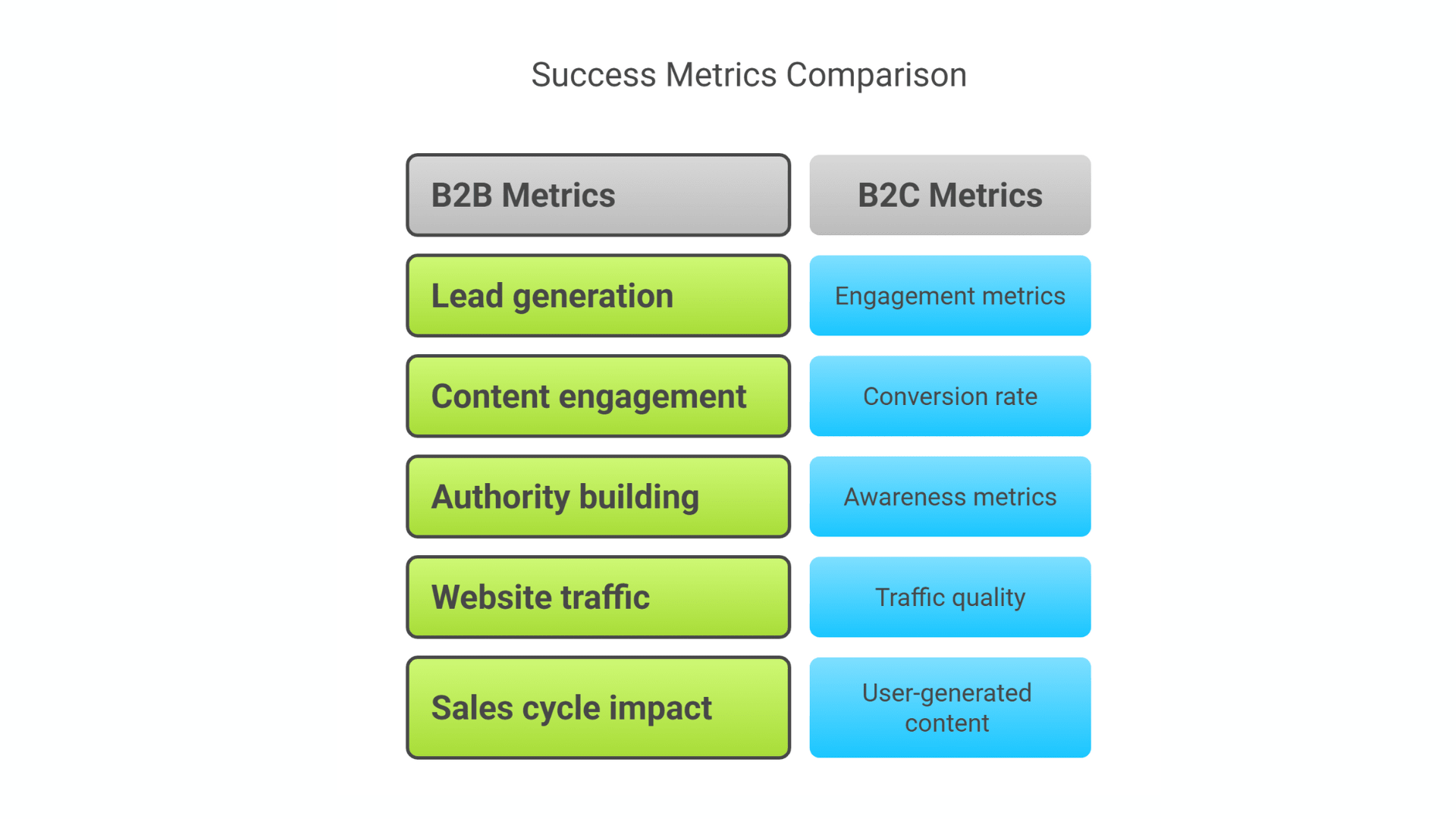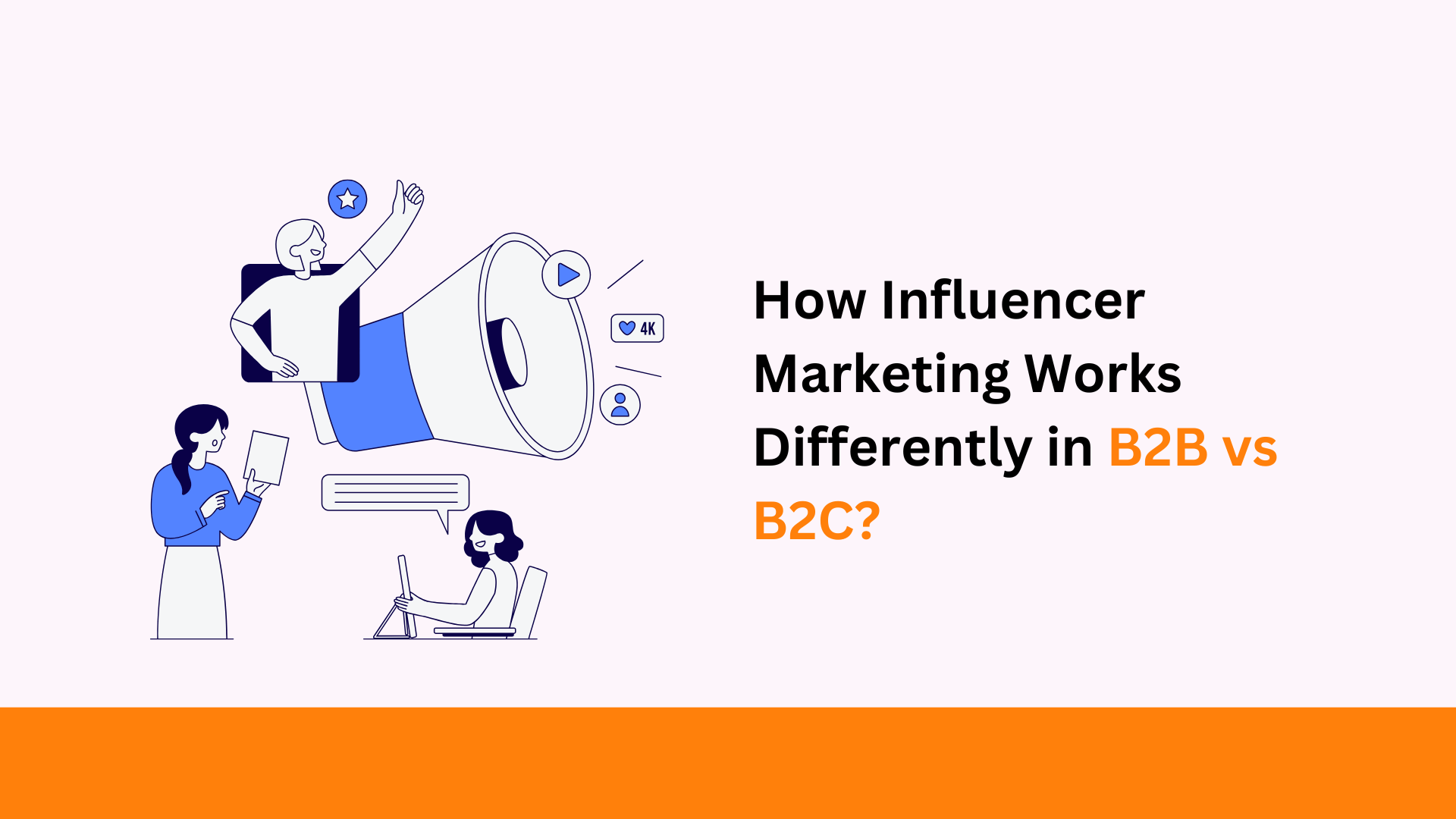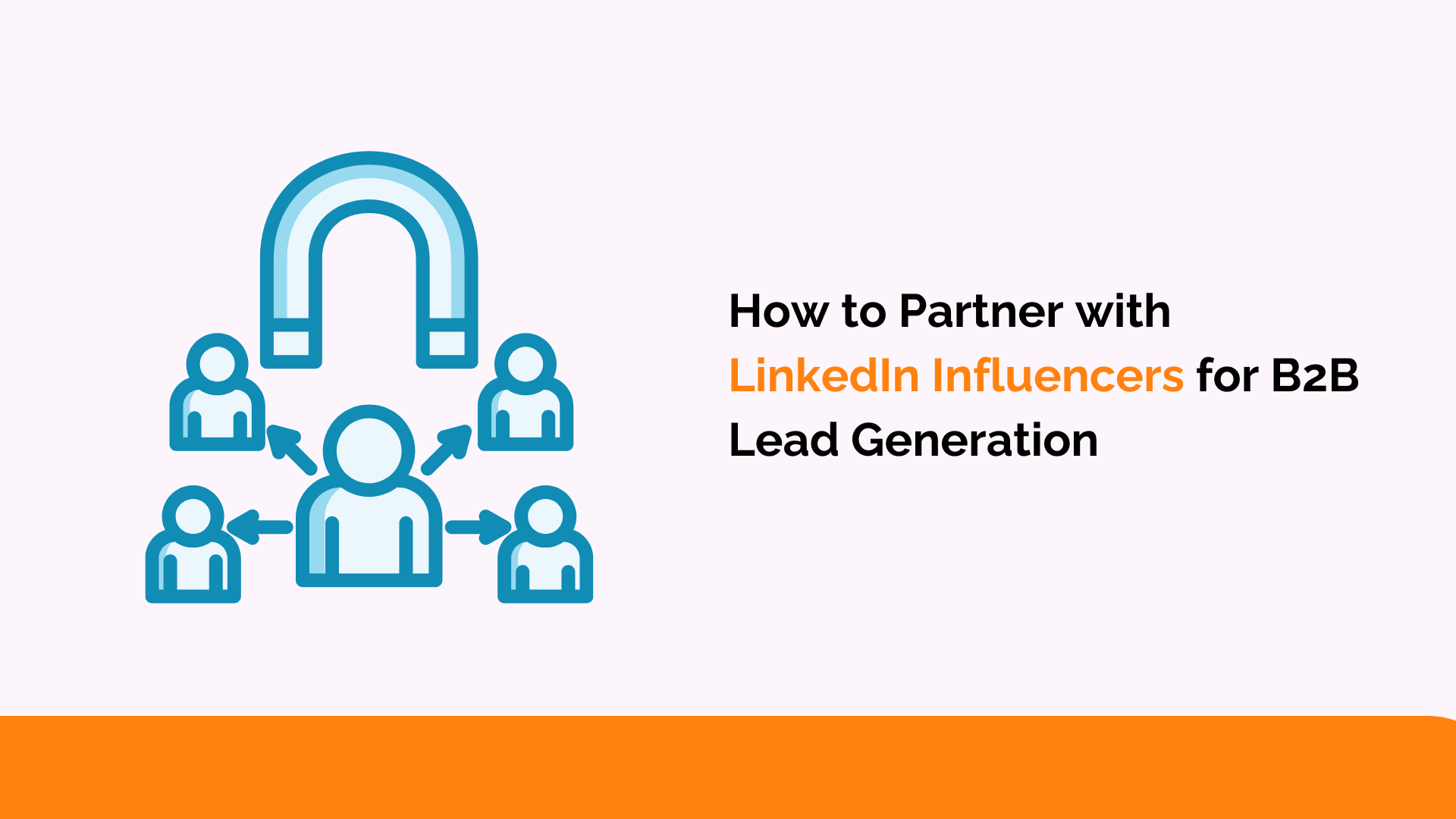TL; DR
Here are the key points on influencer marketing strategies between B2B and B2C:
• Influencer marketing strategies differ between businesses and consumers, and so the approaches diverge.
• In the business-to-business space, the focus is on building trust and authority using industry thought leaders, while in B2C, the focus shifts to engaging popular social influencers.
• B2B campaigns focus on longer sales cycles involving decision-making boards, while B2C campaigns focus on single consumption impulse purchases.
• This difference affects everything from the choice of platforms (LinkedIn or industry forums for B2B, Instagram or TikTok for B2C) to the type of content produced.
• Content strategy varies significantly: whitepapers and webinars for analysis-driven B2B, lifestyle and short videos for feature-driven B2C.
• These disparities are key for marketers in developing influencer strategies for varying business models.
What is Influencer Marketing and Why Does It Work?
Think of influencer marketing as a more sophisticated form of encouraging the public to talk about a business, product, service, or brand. Central to its success is the pre-existing trust and credibility certain individuals command with audiences. Influencer marketing is the way to leverage that trust for your business and marketing needs. For brands looking to implement this strategy effectively, our comprehensive influencer marketing guide for 2025 provides detailed frameworks and actionable approaches.
At its core, influencer marketing capitalizes on the authentic connections that creators have built with their followers over time. Unlike traditional advertising, which interrupts the consumer experience, influencer content integrates naturally into the feeds and platforms where audiences already spend their time. This native approach results in higher engagement rates, with influencer content generating 8x more engagement than brand-created content according to recent studies.
Key reasons why influencer marketing works so effectively:
- Trust Transfer: Influencers transfer their established credibility to your brand through authentic endorsements
- Targeted Reach: Access specific demographics and psychographics with precision that traditional advertising can’t match
- Higher Engagement: Influencer content receives 61% more engagement than brand-created content on the same platforms
- Content Amplification: Get professional-quality content that can be repurposed across multiple marketing channels
- Social Proof at Scale: Leverage psychological principles of social validation to reduce purchase hesitation
The versatility of influencer marketing also contributes to its effectiveness. From micro-influencers with highly engaged niche audiences to macro-influencers with broader reach, brands can tailor partnerships to specific campaign objectives. This flexibility allows for precision targeting that traditional marketing channels simply cannot match.
ROI metrics further validate influencer marketing’s effectiveness. Businesses average $5.78 in earned media value for every $1 spent on influencer marketing, making it one of the most cost-effective channels available. This efficiency becomes even more pronounced when campaigns are structured with clear goals and KPIs.
Perhaps most importantly, influencer marketing taps into the power of social proof the psychological phenomenon where people assume the actions of others reflect correct behavior. When an influencer authentically endorses a product, they’re essentially providing social validation that reduces purchase hesitation and accelerates the buyer journey.
What makes this strategy successful for both B2B and B2C?
The answer can be found in human psychology. We trust things that other people recommend more than what brands say about themselves, which makes influencer marketing work better. Not only does this approach reduce doubt, but it also makes people more likely to pay attention to the message. People naturally respond better to real endorsements from individuals they follow and like than to direct brand ads.
This level of passive trust, though implemented quite differently based on audience, goals, and purchase behavior, remains the same across both B2B and B2C markets.
Another reason influencer marketing works is that it helps deal with industry-wide advertising fatigue. Recommended products and services that come from well-known personalities cut through the clutter, unlike any traditional advertisement can, especially now that audiences have mastered ignoring promotional messages.
These authentic endorsements effortlessly bypass the increasing barriers to genuine advertising that audiences are learning to tune out. Because the message is delivered by a reliable, credible figure, it has no option but to be absorbed as genuine rather than intrusive.
Key Differences in B2B vs B2C Influencer Marketing
The main distinction between B2B and B2C influencer marketing lies with their audience characteristics, their adoption and usage life cycles, and the nature of relationships involved.
B2B influencer marketing is based on the ideas of thought leadership and expertise marketing. The influencers here are seasoned professionals, analysts, consultants, and industry experts who have established credibility based on their work experience. They prefer LinkedIn, professional conferences, webinars, and industry-specific podcasts as their major platforms. The content produced is usually deep and complex, requiring a lot of data and research to solve business problems.
Take, for example, Ann Handley. She is an expert in marketing and is a strong B2B influencer. Along with other businesses, she has their attention when she speaks about content strategy because her suggestions are substantiated with facts and recognition from the industry.
On the other hand, B2C influencer marketing is about employing a favorable emotional response from the audience and mass persuasion. Read the Full-funnel influencer strategy here for B2C
From celebrities to micro-influencers with specific audience segments, these influencers operate on Instagram, TikTok, and YouTube, which are consumer-oriented. Their aim with their content is to entertain, inspire, or educate audiences while marketing products in a subtle manner alongside lifestyle content.
Think of fitness influencers marketing nutrition products as part of their daily routines. They create aspirational content by linking products with the quickly sellable idea of a desirable lifestyle. This is less about product technical details and more about how products impact and improve the lives of consumers.
According to Qoruz , “B2B is more about logic and ROI driven purchases, while B2C focuses more on creating emotional connections that drive purchase behavior.” B2C ad campaigns appear to lead to quicker responses, as customers can make impulse buys right after viewing influencer marketing materials. In the B2B realm, conversions take much longer because of the drawn-out sales cycles and numerous stakeholders involved in business transactions.
Instead of jumping straight to making posts on social media, take time to identify people who actively contribute case studies or deep technical content in your field, such as:
- Keynote speaking assignments at prestigious conferences
- Publishing articles in business magazines or journals specific to your industry
- Executive positions on committees for governing professional associations
- Regular, engaging, and productive participation on LinkedIn
- Interviewing or lecturing on webinars or podcasts related to a specific industry
- Quality content for B2B influencer collaborations typically falls into categories that demonstrate depth and practical value, like: Real-world applications presented in case studies.
- Industry problem-solving efforts are put together in whitepapers.
- Emerging trend analysis in articles
- Breaking down complex concepts in a technical webinar
- Actionable research reports based on factual data.
Scaling challenges faced by marketing teams often emerge when trying to maintain quality content for B2B influencer collaborations, which typically falls into categories that demonstrate depth and practical value, like: Real-world applications presented in case studies.
- Industry problem-solving efforts are put together in whitepapers.
- Emerging trend analysis in articles
- Breaking down complex concepts in a technical webinar
- Actionable research reports based on factual data.
B2B Influencer Marketing Strategies
Unlike B2C marketing, there is no readily available collection of B2B influencers with elaborate performance statistics. These influencers usually require extensive cross-platform research in order to locate and determine their skill level and engagement ratio.
In the words of one B2B marketing expert, “B2B influencers tend to be subject matter experts who hold some form of credential, but they usually do not have the media skills or the following of their B2C counterparts. You are searching for credible influencers who can enhance the discussion for your target audience, not necessarily social media personalities.”
Problems Encountered in B2B Influencer Marketing:
B2B influencer marketing presents unique problems that must be strategically solved. The very first example of this is managing trust and credibility, in which professional reputation comes into play. Some commercial partnerships tend to be contrived or merely transactional. If they do not succeed, they can hurt the influencer’s reputation as well as the brand’s.
Another noteworthy challenge is the lengthy B2B sales cycle. Unlike consumers, who may act within seconds of seeing an influencer’s post, B2B purchase decisions typically take months and involve many people. This requires relevant content from the influencer throughout the entire buying process, from awareness to consideration to decision-making.
In addition, there is always the need to consider regulatory compliance, especially in healthcare, finance, and legal services, which are extremely regulated. Aside from being compelling and engaging, the content also has to follow the industry’s specific regulations on claims, disclaimers, and relationships that need to be revealed.
The challenges with measuring impact are particularly unique with B2B influencer marketing. One agency describes: “Measuring the results of a B2B influencer campaign is a lot more complicated than for B2C. There are many more decision stages and separate interactions by the customers that make tracking attribution difficult; thus, more advanced tracking and a willingness to wait to see the results are needed.”
B2C Influencer Marketing Strategies
Finding the Right Influencers for B2C
There’s a wide range of influencers in the B2C space, including well-known public figures as well as small but fervent social media micro-influencers. These niches can often prove hard to target, which makes aligning with them particularly important, paired with simple, valued metrics.
Generally, B2C influencers can be categorized into different classes, each having its benefits:
- Micro-influencers (10 K- 50 K followers): Usually engage customers the most, or have the most loyal followers. This makes them perfect for nurturing relationships with certain niche segments.
- Mid-tier influencers (50 K- 500 K followers): Strike a balance between reach and a decent level of customer engagement. Ideal for brands that want more relationships while scaling.
- Macro-influencers (500 K- 1 M followers): Great range, but still retain some personal touch to the audience.
- Celebrities (1 M+ followers): Vast reach, but tend to have lower engagement rates. More exposure comes at a higher price premium, though.
The most effective B2C platforms continue to evolve, but currently include:
- Instagram: Still has major clout in the lifestyle, fashion, beauty, and food sectors.
- TikTok: Holds the crown for short-form videos, especially amongst the younger generation who appreciates innovative and original content.
- YouTube: Masters of in-depth reviews, tutorials, and storytelling are on YouTube.
- Pinterest: Has an especially strong grip on content related to home decor and DIY fashion, and recipes.
When engaging B2C influencers, think of the following:
- Is there a clearly defined targeted audience that will buy your product?
- Does their content style align with your brand?
- How frequently do they post? Do they have a good level of visitor interaction?
- Are they able to emotionally connect with the audience through the visuals created?
- Are they experienced in operating contests or writing reviews in an entertaining manner?
B2C Influencer Marketing Challenges
B2C influencers are popular, yet there are notable aspects that are on the weaker side. Market saturation is first on the to-do list, with an increasing number of wannabe influencers and paid advertisements on users’ social media accounts. Due to this increased saturation, it is more and more challenging to get noticed, resulting in audience burnout towards blatant advertisements.
As marketing gets more sophisticated, consumers have had to deal with growing concerns about artificial endorsements. The best-performing B2C influencer campaigns now require much more complicated and authentic brand-influencer relationships beyond simple transactional posts.
The other persistent problem is measuring real ROI. While there is superficial insight stemming from metrics like engagement rates and reach, the complex issue of linking these measures with actual sales lies beneath. Although advanced attribution models and influencer-specific tracking codes allow measuring sales, the customer journey never follows an influencer to a sponsored advertisement and purchase path.
Marketer partner concerns have also intensified brand safety issues as influencers’ past statements or voicing of any off-brand behaviors can resurface at any time and might create association problems for partnered brands. To safeguard brand identity, this requires a minimum level of vetting and continuous monitoring of influencer partners.
Content Strategies for B2B vs. B2C
The strategy to be taken for influencer marketing content is remarkably different in scope for B2B and B2C because of the different nature of the audiences and their decision-making.
When it comes to B2C influencer marketing, nothing captures attention more than visual content. As one marketer puts it, ”Emotionally stimulating content is best displayed through videos. Photos and infographics capturing consumers with your product help them imagine how it fits into their lives.”
Contests and giveaways are another effective form of B2C marketing. These campaigns not only create buzz and encourage participation but also enhance the campaign’s reach via social sharing. Simple entry mechanisms such as tagging friends and sharing posts can significantly improve brand visibility while enhancing positive brand equity.
Authentic reviews and endorsements take the center stage in B2C influencer marketing. One agency suggests,
“Get influencers to use your products and give their candid feedback on their social pages. The more honest those reviews are, the more a brand will be able to drive its consumers to take action.”
In contrast, B2B influencer content is more focused on education and deep analysis. It is also delivered via “knowledge hubs,” webinars, and thought leadership content that positions the brand as practical to the business audience. The objective changes from appealing to emotion to business value and ROI.
Content that incorporates both brand and B2B influencers, such as research reports, whitepapers, or industry trend analyses, serves the dual purpose of enhancing credibility with business audiences while providing value. These projects capitalize on the influencer’s authority while being tailored to the brand’s messaging strategy.
How to Measure Success in B2B vs B2C Influencer Marketing?
Approaches for evaluating success for influencer marketing differ for B2B and B2C campaigns because the systems and the customer journeys are different.

Some metrics that would matter in B2B influencer marketing include:
- Lead generation: New business inquiries in the given timeframe.
- Content engagement: The number of people who had some interactions with complex content, like white papers or webinars.
- Authority building: Share of voice in industry conversations.
- Website traffic: Visits on high-value resource pages or solution pages.
- Sales cycle impact: Reduction in the time from the first contact to the last possible day they can close.
Most of these metrics are well-suited for the longer, more complex B2B purchase journey, which rarely results in immediate conversions. Success often means moving professional audiences through progressive stages of industry authority recognition and consideration.
On the other hand, B2C influencer marketing usually focuses on measuring:
- Engagement metrics: Likes, comments, shares, saves, etc.
- Conversion rate: The number of people who purchased the product using the tracking link or the promo code.
- Awareness metrics: Volume of the brand mentions and the prevailing sentiment.
- Traffic quality: Time on site and bounce rates coming from the influencer.
- User-generated content: The volume and quality of consumer content derived from the marketing campaigns.
With B2C purchases, there is a clearly defined purchase intention that needs to be tapped into, hence the need for an emotional connection.
Both B2B and B2C measurement becomes more complex upon the application of proper attribution models, which look further into the brand’s entire customer journey as opposed to just the first or last contact interaction.
If you are confused about when to use influencer marketing and other channels like paid ads, then we’ve curated an article to solve the dilemma for you.
The Future of B2B & B2C Influencer Relations Marketing
For both B2B and B2C, the world of influencer marketing is shifting and changing at a very high pace, with some new trends that have set themselves in the “best practice” way. Arguably, the single most important trend affecting all dimensions, from choosing an influencer strategy to content and performance optimization, is AI.
AI has also been integrated in ways that allow brands to utilize new tools that analyze patterns within content, audience overlap, engagement rate, and authenticity to determine the most suitable influencers to partner with. These new tools have AI integrated in nature and therefore, can scrutinize and analyze enormous volumes of data, which surpass human capability to recognize where successful collaborative relations are present.
Both sectors are shifting gears towards a proactive approach and moving from ad hoc campaigns to structured programs, which is a “from one-off” program approach rather than a recurrent promo posts approach. In other words, authentic influence takes time to build, hence, brands are increasingly making these influencers part of their extended marketing team rather than as external promoters.
Surprisingly, a number of B2B influencer marketing trends appear to be following already established B2C patterns. As one expert notes, “What’s next for B2B? Simply look at B2C. A lot of relationship management, content marketing, and everything else paid for were done in the consumer world before B2B customized it to the intricacies of enterprise relationships.”
The phenomenon of “consumerization” in B2B marketing persists, with previously consumer-centric content formats such as unboxing videos and product showcases migrating to business contexts. This suggests that while a deep divide in B2B and B2C influencer marketing remains, the approaches and content formats have begun to blend.
Also, read about the emerging trends in influencer marketing in 2025.
FAQs
- What are the primary differences between B2B and B2C influencer marketing systems?
B2B influencer marketing focuses on building influence through expert content that demonstrates industry knowledge. Campaigns provide educational content and analysis that offers solutions to problems. Relationship building happens intentionally over time, matching the extended B2B sales cycle.
B2C influencer marketing engages audiences through lifestyle imagery and everyday scenarios. These campaigns leverage the bond between influencers and followers, focusing on how products are used in daily life rather than technical details.
- What platform is best suited for B2B influencer marketing?
LinkedIn leads for B2B influencer marketing with its professional focus and business-oriented content formats. Twitter serves as a supplemental channel for quick industry insights and conversations. Professional forums, blogs, and specialized networks for B2B podcasts round out the ecosystem. Platform selection should align with where industry decision-makers engage with content.
- How is ROI measured in influencer marketing?
B2B ROI measurement involves tracking leads generated, assessing quality through conversion rates, measuring content engagement depth, and monitoring brand perception changes among target accounts.
B2C revenue is easier to track using discount codes, UTM parameters, and affiliate links that directly connect influencer activity to purchases. Engagement metrics provide supporting evidence, especially when comparing baseline to influencer-driven engagement.
- Should brands depend on micro or macro-influencers?
B2B companies typically find more value in micro-influencers with relevant expertise and quality networks. Credibility and audience quality matter more than reach.
For B2C brands, micro-influencers offer high engagement and authenticity for specific segments, while macro-influencers serve mass market awareness objectives. Many successful campaigns strategically combine both tiers.
- How does influencer marketing use AI?
AI helps influencer marketing through discovery and selection by analyzing engagement data to find the right match. It aids fraud detection by identifying fake followers and engagement patterns. AI can predict content performance based on past results and platform algorithms, enabling data-driven planning. Content analysis helps measure impact and tailor future creative direction.



